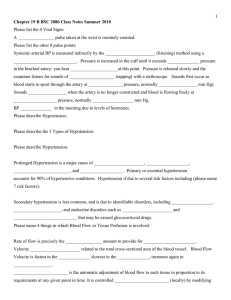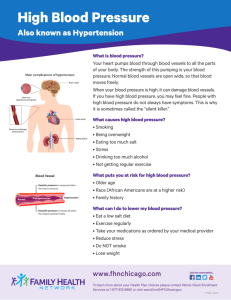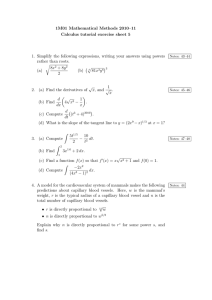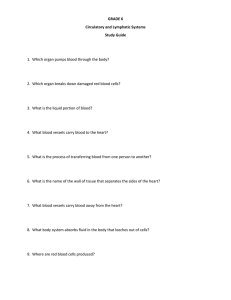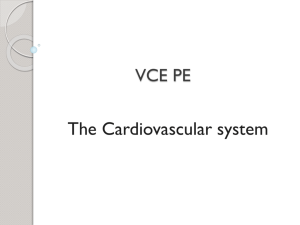Chap 19B
advertisement
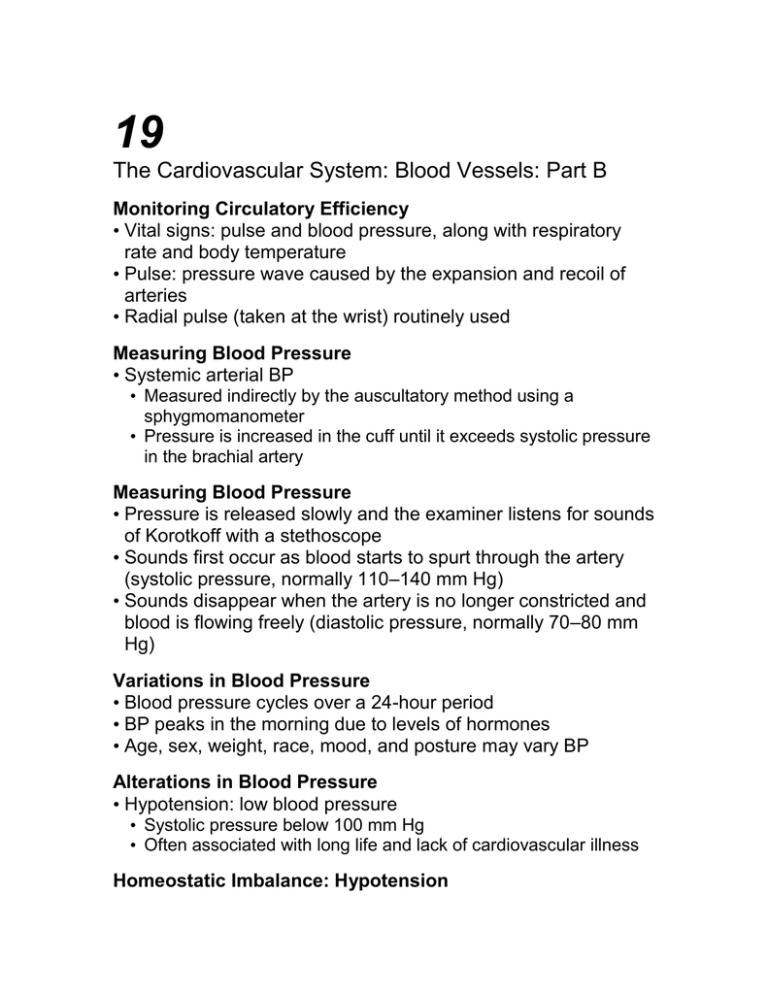
19 The Cardiovascular System: Blood Vessels: Part B Monitoring Circulatory Efficiency • Vital signs: pulse and blood pressure, along with respiratory rate and body temperature • Pulse: pressure wave caused by the expansion and recoil of arteries • Radial pulse (taken at the wrist) routinely used Measuring Blood Pressure • Systemic arterial BP • Measured indirectly by the auscultatory method using a sphygmomanometer • Pressure is increased in the cuff until it exceeds systolic pressure in the brachial artery Measuring Blood Pressure • Pressure is released slowly and the examiner listens for sounds of Korotkoff with a stethoscope • Sounds first occur as blood starts to spurt through the artery (systolic pressure, normally 110–140 mm Hg) • Sounds disappear when the artery is no longer constricted and blood is flowing freely (diastolic pressure, normally 70–80 mm Hg) Variations in Blood Pressure • Blood pressure cycles over a 24-hour period • BP peaks in the morning due to levels of hormones • Age, sex, weight, race, mood, and posture may vary BP Alterations in Blood Pressure • Hypotension: low blood pressure • Systolic pressure below 100 mm Hg • Often associated with long life and lack of cardiovascular illness Homeostatic Imbalance: Hypotension • Orthostatic hypotension: temporary low BP and dizziness when suddenly rising from a sitting or reclining position • Chronic hypotension: hint of poor nutrition and warning sign for Addison’s disease or hypothyroidism • Acute hypotension: important sign of circulatory shock Alterations in Blood Pressure • Hypertension: high blood pressure • Sustained elevated arterial pressure of 140/90 or higher • May be transient adaptations during fever, physical exertion, and emotional upset • Often persistent in obese people Homeostatic Imbalance: Hypertension • Prolonged hypertension is a major cause of heart failure, vascular disease, renal failure, and stroke • Primary or essential hypertension • 90% of hypertensive conditions • Due to several risk factors including heredity, diet, obesity, age, stress, diabetes mellitus, and smoking Homeostatic Imbalance: Hypertension • Secondary hypertension is less common • Due to identifiable disorders, including kidney disease, arteriosclerosis, and endocrine disorders such as hyperthyroidism and Cushing’s syndrome Blood Flow Through Body Tissues • Blood flow (tissue perfusion) is involved in • Delivery of O2 and nutrients to, and removal of wastes from, tissue cells • Gas exchange (lungs) • Absorption of nutrients (digestive tract) • Urine formation (kidneys) • Rate of flow is precisely the right amount to provide for proper function Velocity of Blood Flow • Changes as it travels through the systemic circulation • Is inversely related to the total cross-sectional area • Is fastest in the aorta, slowest in the capillaries, increases again in veins • Slow capillary flow allows adequate time for exchange between blood and tissues Autoregulation • Automatic adjustment of blood flow to each tissue in proportion to its requirements at any given point in time • Is controlled intrinsically by modifying the diameter of local arterioles feeding the capillaries • Is independent of MAP, which is controlled as needed to maintain constant pressure Autoregulation • Two types of autoregulation 1. Metabolic 2. Myogenic Metabolic Controls • Vasodilation of arterioles and relaxation of precapillary sphincters occur in response to • Declining tissue O2 • Substances from metabolically active tissues (H+, K+, adenosine, and prostaglandins) and inflammatory chemicals Metabolic Controls • Effects • Relaxation of vascular smooth muscle • Release of NO from vascular endothelial cells • NO is the major factor causing vasodilation • Vasoconstriction is due to sympathetic stimulation and endothelins Myogenic Controls • Myogenic responses of vascular smooth muscle keep tissue perfusion constant despite most fluctuations in systemic pressure • Passive stretch (increased intravascular pressure) promotes increased tone and vasoconstriction • Reduced stretch promotes vasodilation and increases blood flow to the tissue Long-Term Autoregulation • Angiogenesis • Occurs when short-term autoregulation cannot meet tissue nutrient requirements • The number of vessels to a region increases and existing vessels enlarge • Common in the heart when a coronary vessel is occluded, or throughout the body in people in high-altitude areas Blood Flow: Skeletal Muscles • At rest, myogenic and general neural mechanisms predominate • During muscle activity • Blood flow increases in direct proportion to the metabolic activity (active or exercise hyperemia) • Local controls override sympathetic vasoconstriction • Muscle blood flow can increase 10 or more during physical activity Blood Flow: Brain • Blood flow to the brain is constant, as neurons are intolerant of ischemia • Metabolic controls • Declines in pH, and increased carbon dioxide cause marked vasodilation • Myogenic controls • Decreases in MAP cause cerebral vessels to dilate • Increases in MAP cause cerebral vessels to constrict Blood Flow: Brain • The brain is vulnerable under extreme systemic pressure changes • MAP below 60 mm Hg can cause syncope (fainting) • MAP above 160 can result in cerebral edema Blood Flow: Skin • Blood flow through the skin • Supplies nutrients to cells (autoregulation in response to O2 need) • Helps maintain body temperature (neurally controlled) • Provides a blood reservoir (neurally controlled) Blood Flow: Skin • Blood flow to venous plexuses below the skin surface • Varies from 50 ml/min to 2500 ml/min, depending on body temperature • Is controlled by sympathetic nervous system reflexes initiated by temperature receptors and the central nervous system Temperature Regulation • As temperature rises (e.g., heat exposure, fever, vigorous exercise) • Hypothalamic signals reduce vasomotor stimulation of the skin vessels • Heat radiates from the skin Temperature Regulation • Sweat also causes vasodilation via bradykinin in perspiration • Bradykinin stimulates the release of NO • As temperature decreases, blood is shunted to deeper, more vital organs Blood Flow: Lungs • Pulmonary circuit is unusual in that • The pathway is short • Arteries/arterioles are more like veins/venules (thin walled, with large lumens) • Arterial resistance and pressure are low (24/8 mm Hg) Blood Flow: Lungs • Autoregulatory mechanism is opposite of that in most tissues • Low O2 levels cause vasoconstriction; high levels promote vasodilation • Allows for proper O2 loading in the lungs Blood Flow: Heart • During ventricular systole • Coronary vessels are compressed • Myocardial blood flow ceases • Stored myoglobin supplies sufficient oxygen • At rest, control is probably myogenic Blood Flow: Heart • During strenuous exercise • Coronary vessels dilate in response to local accumulation of vasodilators • Blood flow may increase three to four times Blood Flow Through Capillaries • Vasomotion • Slow and intermittent flow • Reflects the on/off opening and closing of precapillary sphincters Capillary Exchange of Respiratory Gases and Nutrients • Diffusion of • O2 and nutrients from the blood to tissues • CO2 and metabolic wastes from tissues to the blood • Lipid-soluble molecules diffuse directly through endothelial membranes • Water-soluble solutes pass through clefts and fenestrations • Larger molecules, such as proteins, are actively transported in pinocytotic vesicles or caveolae Fluid Movements: Bulk Flow • Extremely important in determining relative fluid volumes in the blood and interstitial space • Direction and amount of fluid flow depends on two opposing forces: hydrostatic and colloid osmotic pressures Hydrostatic Pressures • Capillary hydrostatic pressure (HPc) (capillary blood pressure) • Tends to force fluids through the capillary walls • Is greater at the arterial end (35 mm Hg) of a bed than at the venule end (17 mm Hg) • Interstitial fluid hydrostatic pressure (HPif) • Usually assumed to be zero because of lymphatic vessels Colloid Osmotic Pressures • Capillary colloid osmotic pressure (oncotic pressure) (OPc) • Created by nondiffusible plasma proteins, which draw water toward themselves • ~26 mm Hg • Interstitial fluid osmotic pressure (OPif) • Low (~1 mm Hg) due to low protein content Net Filtration Pressure (NFP) • NFP—comprises all the forces acting on a capillary bed • NFP = (HPc—HPif)—(OPc—OPif) • At the arterial end of a bed, hydrostatic forces dominate • At the venous end, osmotic forces dominate • Excess fluid is returned to the blood via the lymphatic system Circulatory Shock • Any condition in which • Blood vessels are inadequately filled • Blood cannot circulate normally • Results in inadequate blood flow to meet tissue needs Circulatory Shock • Hypovolemic shock: results from large-scale blood loss • Vascular shock: results from extreme vasodilation and decreased peripheral resistance • Cardiogenic shock results when an inefficient heart cannot sustain adequate circulation Circulatory Pathways • Two main circulations • Pulmonary circulation: short loop that runs from the heart to the lungs and back to the heart • Systemic circulation: long loop to all parts of the body and back to the heart Differences Between Arteries and Veins Developmental Aspects • Endothelial lining arises from mesodermal cells in blood islands • Blood islands form rudimentary vascular tubes, guided by cues such as vascular endothelial growth factor • The heart pumps blood by the 4th week of development Developmental Aspects • Fetal shunts (foramen ovale and ductus arteriosus) bypass nonfunctional lungs • Ductus venosus bypasses the liver • Umbilical vein and arteries circulate blood to and from the placenta Developmental Aspects • Vessel formation occurs • To support body growth • For wound healing • To rebuild vessels lost during menstrual cycles • With aging, varicose veins, atherosclerosis, and increased blood pressure may aris
